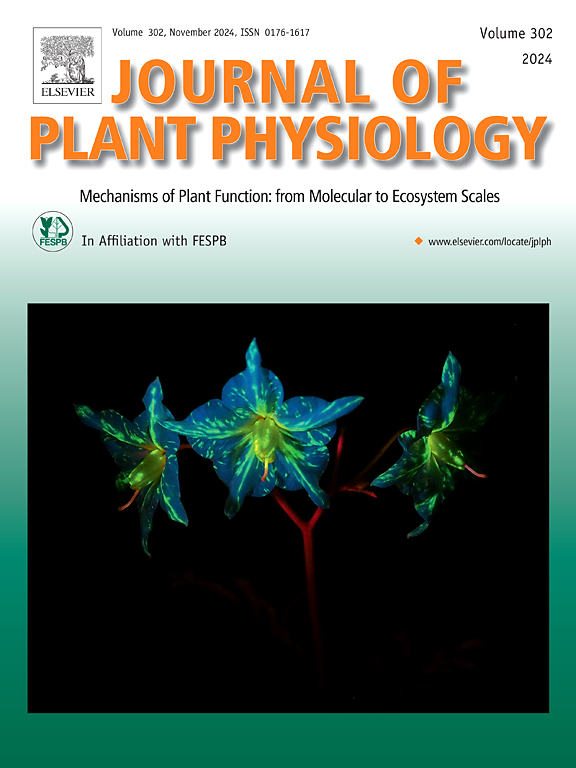Plastid- and photoreceptor-dependent signaling is required for the response to photoperiod stress
IF 4
3区 生物学
Q1 PLANT SCIENCES
引用次数: 0
Abstract
Prolongation of the light period causes photoperiod stress in plants. The response to photoperiod stress includes the induction of a distinct set of stress marker genes, of reactive oxygen species (ROS), and of stress hormones. In this study, the impact of light intensity and light quality on the photoperiod stress response was investigated. A threshold light intensity of circa 50 μmol m−2 s−1 is necessary for inducing photoperiod stress, indicating the involvement of chloroplasts. Lower photoperiod stress symptoms in retrograde signaling mutants (gun4, gun5) and mutants with constrained plastid function (glk1 glk2) corroborated the role of chloroplasts. Genetic analysis revealed that the photoreceptors phyB and particularly CRY2 are important to perceive photoperiod stress. Overall, these results showed that both plastid-dependent and photoreceptor-dependent signaling pathways are involved in sensing the light conditions causing photoperiod stress and governing the response to it.
质体和光感受器依赖的信号是响应光周期胁迫所必需的。
光周期的延长引起植物的光周期胁迫。对光周期胁迫的反应包括诱导一组不同的应激标记基因、活性氧(ROS)和应激激素。本文研究了光强和光质量对光周期胁迫响应的影响。诱导光周期胁迫所需的阈值光强约为50 μmol m-2 s-1,表明叶绿体参与了胁迫。逆行信号突变体(gun4、gun5)和质体功能受限突变体(glk1、glk2)的低光周期应激症状证实了叶绿体的作用。遗传分析表明,光感受器phyB,特别是CRY2在感知光周期胁迫中起重要作用。总的来说,这些结果表明,质体依赖和光感受器依赖的信号通路都参与感知引起光周期胁迫的光条件并控制对它的反应。
本文章由计算机程序翻译,如有差异,请以英文原文为准。
求助全文
约1分钟内获得全文
求助全文
来源期刊

Journal of plant physiology
生物-植物科学
CiteScore
7.20
自引率
4.70%
发文量
196
审稿时长
32 days
期刊介绍:
The Journal of Plant Physiology is a broad-spectrum journal that welcomes high-quality submissions in all major areas of plant physiology, including plant biochemistry, functional biotechnology, computational and synthetic plant biology, growth and development, photosynthesis and respiration, transport and translocation, plant-microbe interactions, biotic and abiotic stress. Studies are welcome at all levels of integration ranging from molecules and cells to organisms and their environments and are expected to use state-of-the-art methodologies. Pure gene expression studies are not within the focus of our journal. To be considered for publication, papers must significantly contribute to the mechanistic understanding of physiological processes, and not be merely descriptive, or confirmatory of previous results. We encourage the submission of papers that explore the physiology of non-model as well as accepted model species and those that bridge basic and applied research. For instance, studies on agricultural plants that show new physiological mechanisms to improve agricultural efficiency are welcome. Studies performed under uncontrolled situations (e.g. field conditions) not providing mechanistic insight will not be considered for publication.
The Journal of Plant Physiology publishes several types of articles: Original Research Articles, Reviews, Perspectives Articles, and Short Communications. Reviews and Perspectives will be solicited by the Editors; unsolicited reviews are also welcome but only from authors with a strong track record in the field of the review. Original research papers comprise the majority of published contributions.
 求助内容:
求助内容: 应助结果提醒方式:
应助结果提醒方式:


